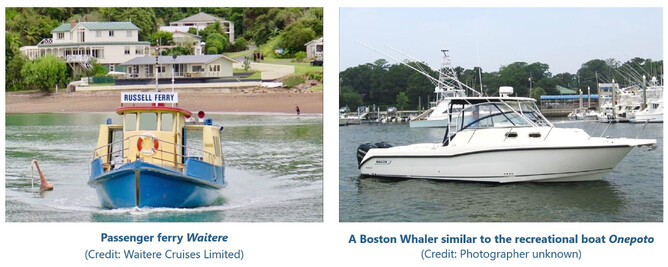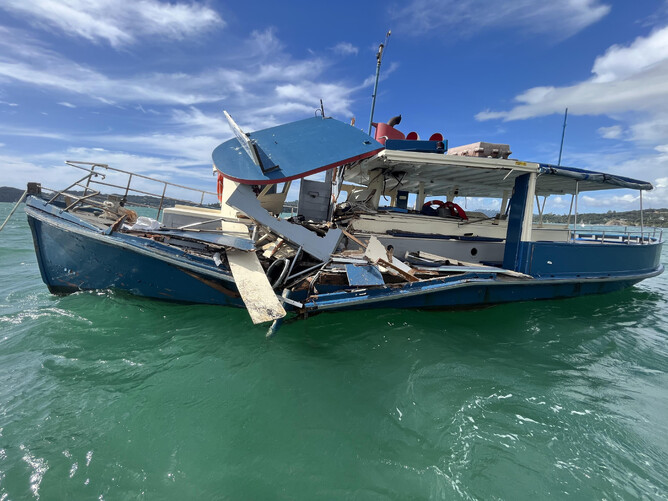NB: The below is a brief plain English summary of key points in the report. The Commission's report speaks for itself -- you can download the full document here:
www.taic.org.nz/inquiry/mo-2023-202.
Key point: All skippers must keep a good watch and can't rely on other skippers keeping to the rules. Lessons in this report around watchkeeping and speed are useful for seafarers, owners, operators, and insurers, boat clubs, local councils and harbour masters.
What happened
The recreational vessel Onepoto collided with the passenger ferry Waitere, known locally as the Blue Ferry, while the ferry was on its way from Russel to Paihia.
The TAIC report describes catastrophic damage to the Waitere, which later sank. The Waitere's master was seriously injured but its 19 passengers were largely uninjured. The Onepoto's skipper and passenger were uninjured but there was some damage to the boat.
Why it happened
Both vessels' navigation was unsafe. Almost certainly, this was because neither skipper kept a proper watch. Both did eventually see the other vessel, but too late to take avoiding action.
The Onepoto was navigating at 20.5 knots while its skipper was distracted by an engine alarm. Had the skipper reduced speed while attending to the engine alarm, it's very likely the collision would have been avoided or its consequences diminished.
Safety issue: good watchkeeping, lookout practices
Regulations require every maritime transport operator to detail the risks and planned mitigations for each of their vessels in a Maritime Transport Operator Plan (MTOP). But the MTOP for the Waitere didn't do that; it:
omitted procedures for safe watchkeeping and keeping a good lookout;
contained ambiguities, irrelevant and inaccurate information; and
didn't identify and mitigate the risk of the sole-charge master being incapacitated.
And the regulatory system didn't detect the problems with the Waitere's MTOP.
Regulatory focus negates need for recommendation
There was no need for the Commission to make a new recommendation for future safety. The regulator, Maritime NZ, engages in sufficient promotion of good watchkeeping and lookout practices via safety audits, guidance publications, and prosecuting where the rules are broken. And Maritime NZ engages more deeply with operators on certification and audit work.
Lessons
Lessons for all skippers:
Proper lookout: look and listen and do everything you can to determine if there's a risk of collision. In a crossing situation, regardless of which vessel is designated to give way, both must be vigilant. Both must keep track of how they're doing at avoiding the other vessel until they are clear of each other.
Sensible speed: ensure your speed gives you time to determine if you could collide and enables you to stop in a safe distance if required.
No repeat accidents – ever!
The principal purpose of the Transport Accident Investigation Commission is to determine the circumstances and causes of aviation, marine, and rail accidents and incidents with a view to avoiding similar occurrences in the future, rather than to ascribe blame to any person. TAIC opens an inquiry when it believes the reported circumstances of an accident or incident have - or are likely to have - significant implications for transport safety, or when the inquiry may allow the Commission to make findings or recommendations to improve transport safety.

